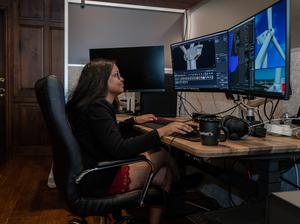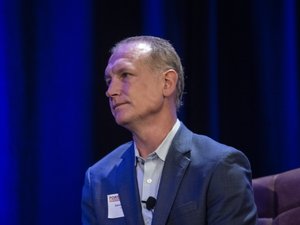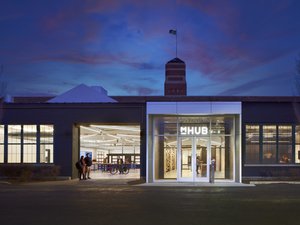
On a sunny morning in January, students from Carthage College gathered in a barren field in Van Horn, Texas, to watch Blue Origin’s New Shepherd launch vehicle take off. Over the next 11 minutes, the unmanned suborbital rocket system would soar past the von Kármán line — the internationally-recognized boundary of space — until it reached a point of weightlessness.
A few minutes later, the booster would return to ground, seamlessly landing in the vertical position, followed by the capsule gently parachuting back to Earth.
“The intensity of the light is kind of blinding, even in the bright light of the morning sun,” says Kevin Crosby, a Carthage College professor of physics, astronomy and computer science, who accompanied the students at the launch. “Everybody holds their breath as it slowly crawls into the sky. It defies your intuition when you see this skinny object falling out of the sky, and then ‘bullseye.’”
It landed right in the field it launched from.
Then there’s the sonic boom. “It blows your mind,” he added.
As if witnessing a rocket launch wasn’t thrilling enough, these students were fulfilling a mission of their own. Aboard the Blue Origin flight that exciting morning, the New Shepherd launch vehicle was carrying eight research payloads — including one the Carthage Microgravity Team developed in partnership with NASA. Blue Origin is a private space company founded by Amazon CEO Jeff Bezos.
The team was tasked with addressing a one-billion dollar a year problem for the space agency: trying to figure out how much fuel is in the tank in anti-gravity environments.
Since the Apollo first landed on the moon, propulsion gauging has been a critical issue, explained Crosby. Without knowing a spacecraft’s fuel levels, NASA is forced to provide up to $2.5 million in extra propellant every time it sends a satellite into orbit — just to carve out enough margin.
“It’s $2.5 million in unknowns,” says Crosby, who also serves as director of the NASA Wisconsin Space Grant Consortium. “These are very basic things you think would be solved.”
In addition to easing costs in the satellite delivery industry, NASA is busy working behind the scenes with Blue Origin to achieve its other ambitions — mainly cornering the “orbital market” by successfully sending humans to space via commercial space flights.
But the organizations can’t reach their goals without getting an accurate take on fuel levels during flights.
“It’s a critical roadmap,” Crosby says.
So in a joint effort with the NASA Kennedy Space Center Cryogenics Laboratory, Carthage students went to work developing technology for the Modal Propellant Gauging project, known effectively as MPG. The school has worked with NASA on MPG projects since 2011.
Led by Crosby, the students spent more than four months brainstorming ideas until they put anything on paper.
“That was my favorite part,” says Crosby. “We’d sit around with whiteboards and laptops and talk about how much we don’t know.” Finally, the students came up with a solution: detecting fuel levels in microgravity by using sound waves.
Using Experimental Modal Analysis (EMA), the team used a liquid-loaded tank to detect vibrational shifts as liquid was drained from the container.
The idea is not all that different from sliding a wet finger across the rim of a glass and hearing different pitches according to the amount of liquid present in each cup, Crosby said. By measuring vibration frequencies and turning the acoustic sounds into mathematical equations, the team could meter out whether the model tank had two gallons of fuel — or two gallons of fuel minus a teaspoon. It’s that precise.
Building out the technology for the suborbital flight posed a different challenge, however. After creating several test models, the team had to create a smaller version to fit into the payload locker aboard the New Shepherd, and it had to run autonomously which required the team to essentially build a robot — one that could turn itself on, monitor its conditions, take measurements, and turn itself off. And it had to do so all while withstanding the pressure of an anti-gravity environment, something Crosby equates to the feeling of “ten elephants jumping on your chest for 10 minutes.”
The students spent more than 18 hours in the lab at times constructing the hardware, he adds.
The students participating in the MPG program are all volunteers. While Carthage College has worked with NASA on a diverse number of projects for nearly 15 years, the school doesn’t have a dedicated research staff, or its own lab. In fact, the students — some still in high school — don’t even complete coursework for the grants program.
It’s a project born entirely out of passion, says Crosby.
“It seems like an impossible dream for many of our students, including our rural ones,” he says. “But, we can show them that it’s a possibility. They are willing to try and fail. You don’t see projects like these come out of a small, private university. We punch above our weight.”
Standing in the field in West Texas swelling with pride over his students and their hard work, Crosby said he was reminded of Blue Origin’s motto: “Gradatim Ferociter,” or “Step by step, ferociously.”
“Wisconsin is contributing at the highest levels to aerospace research, and economic development around aerospace,” Crosby says. “It’s really fertile ground for innovation and entrepreneurship.”
“We might be on a human flight,” he adds. “It’s very exciting.”








